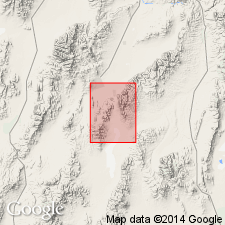
- Usage in publication:
-
- Wenban Limestone*
- Modifications:
-
- Named
- Biostratigraphic dating
- Mapped
- Dominant lithology:
-
- Limestone
- AAPG geologic province:
-
- Great Basin province
Summary:
Pg. 12, 29-38, pI. 1 (geol. map), pl. 2 (fossil locs.). Wenban Limestone. Name applied to Devonian limestone exposed on western flank of Wenban Peak, south of Cortez, in lower plate of Roberts thrust (eastern facies). Has gradational contact with underlying Roberts Mountains Limestone. Base taken at first bioclastic limestone bed above thin-bedded gray pyrite-bearing limestone with monograptids of the Roberts Mountain Limestone. Above this is 2,000 feet of interbedded dark-gray thick-bedded bioclastic limestone interbedded with thin-bedded argillaceous gray to yellow-gray weathering slabby limestones. Underlies Pilot Shale. Approximate equivalent of Nevada (restricted) and Devils Gate Limestones. Age is Early, Middle, and Late Devonian, based on fossils (ostracodes, brachiopods, trilobites, corals, conodonts, stromatoporoids, pteropods, STYLIOLINA, TENTACULITES). Report includes geologic map, measured section, faunal lists.
Named from best exposures on western flank of Wenban Peak, south of Cortez, Cortez 15-min quadrangle, Lander and Eureka Cos., north-central NV.
Source: Publication; US geologic names lexicon (USGS Bull. 1350, p. 816).
For more information, please contact Nancy Stamm, Geologic Names Committee Secretary.
Asterisk (*) indicates published by U.S. Geological Survey authors.
"No current usage" (†) implies that a name has been abandoned or has fallen into disuse. Former usage and, if known, replacement name given in parentheses ( ).
Slash (/) indicates name conflicts with nomenclatural guidelines (CSN, 1933; ACSN, 1961, 1970; NACSN, 1983, 2005, 2021). May be explained within brackets ([ ]).

